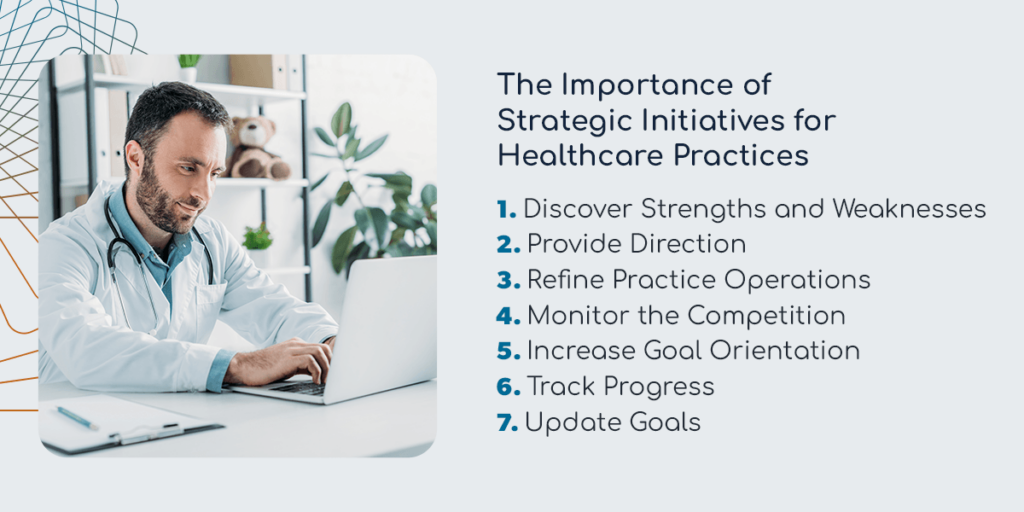December 6, 2019
7 Reasons Strategic Planning in Healthcare Practices Is Essential
Healthcare is a flooded market. While everyone needs a doctor that they can rely on, there are advertisements for different health offices on every street corner. This makes it difficult for potential clients to decipher what differentiates one practice from another. Additionally, it limits the ways businesses can stand out from the crowd.
In order for medical practices to differentiate themselves from the competition, they need a strategic plan. This article outlines strategic planning in healthcare and seven reasons why it’s critical.
What Is Strategic Planning in Healthcare?
Strategic planning in healthcare is a plan of action that helps people achieve their goals while considering the industry’s complexities.
The planning process starts with assessing the healthcare organization’s overarching vision, mission, and goals. From there, organizations consider what tasks and decisions will help them achieve those goals. The final step is to compile this information into a single document, implement the necessary changes, and monitor progress.

The Importance of Strategic Initiatives for Healthcare Practices
Here are seven reasons why strategic planning is beneficial for medical practices.

1. Discover Strengths and Weaknesses
Today’s independent practices face a host of exciting challenges. However, the day-to-day demands of running a medical practice can leave little time for internal assessment. Building a strategic plan allows businesses to look inward and uncover areas that need improvement.
One way to accomplish this is to hand out questionnaires to physicians and key staff members. Each questionnaire can include “1 to 10” style questions that focus on the mistakes, opportunities, liabilities, improvements, and setbacks they see with the practice. Performing these questionnaires in a sit-down can also lead to further discussion of the “why” behind their answers, providing more in-depth feedback.
These answers are critical to building new business plans. They offer insights into the business’s current status and how to enhance its strengths while remedying its weaknesses.
2. Provide Direction
With all the different physicians, nurses, and administrative employees in a practice, it’s hard to get everyone on the same track. That’s why a mission statement is so important — it gives employees a goal to strive for and a shared purpose to motivate their actions. It also creates a “measuring stick” for whether they’re meeting those goals and a plan for realigning with them.
Employees often feel inspired and motivated when they align around a common goal. This positive energy can result in increased productivity and work satisfaction. However, most businesses take a few attempts to get their mission statement right. Come up with a few rough drafts and get feedback from employees and important stakeholders to modify it.
3. Refine Practice Operations
While having an influx of patients and appointments can be good for business, it can result in operational inefficiencies. Focus on compliance can also slip while everyone is busy.
Practices can overcome this challenge by assessing their operations during the strategic planning process. Look at telephone systems, locations, billing and coding practices, marketing initiatives, supply costs, data storage, transactions, and more. This process is vital to uphold business reputation and enhance employee productivity. Businesses can use the uncovered pain points to strengthen strategies.
4. Monitor the Competition
Healthcare practices can learn many lessons from their clients, mentors, and other companies in the industry. However, competition often provides the most insight into the best business strategies. During strategy creation, businesses often consider their competitor’s approach to business, how they source patients, what telecommunications they use, and other best practices.
Assessing current marketplace trends, community needs, and applicable industry projections is also beneficial. After this phase is complete, practices should have a firm idea of what their final mission statement should be.
5. Increase Goal Orientation
Strategic planning offers healthcare practices an opportunity to outline their goals. These goals give businesses steps to hit along the way. Once research and assessment are complete, practices can create goals that align with their vision for success. There should be a healthy mix of long-term and short-term goals, ranging from specific to general. Having clear, measurable goals will make it easier to assess progress in the future.
It can also help to gather trusted and loyal employees and leadership to discuss goal setting. Use their opinions and advice on proposed goals to refine and shape them into something the entire practice believes in.
6. Track Progress
With a strategic plan, businesses have a list of goals, missions, and feedback they can rely on in order to track progress. They may meet quarterly to see what improvements they’ve made and which areas they aren’t living up to. For healthcare practices, this process can result in operation improvements, happier staff, and quality patient care.
For all employees, a strategic plan also serves as a reminder of the expectations they agreed to about their work. While conversations around unmet expectations can be uncomfortable, a strategic plan will provide accountability and reignite motivation to achieve their goals.
7. Update Goals
As years pass, business plans become outdated due to internal and external changes. Luckily, redoing the entire strategic planning process is unnecessary. Businesses only need to revisit their goals and update those that are no longer relevant. With a documented plan, updating goals is quick and easy. It also serves as a reminder of past goals so the practice and its people don’t lose sight of where they want to be.
Challenges With Strategic Planning in Healthcare
Strategic planning is a vital tool to ensure business success. However, failure to account for challenges specific to the healthcare industry can result in a plan that doesn’t hold up to the test of time. Regulations, technology, and patient care are ever-evolving. Every strategic plan should include provisions for these challenges so organizations can align with their goals while adjusting to change.

Consider the following when crafting a healthcare strategic plan:
- Evolving technologies: Remote monitoring devices, cloud computing, bioprinting, and robotics are revolutionizing patient care. With a comprehensive strategy, medical practices can stay ahead of trends and easily integrate them.
- Telehealth: Telehealth and remote appointments are recent developments. Practices can use their strategic plan to adjust their staffing and services to meet changing patient needs.
- Cybersecurity: Cybersecurity risks are an increasing problem as technology and scammer tactics advance. Organizations must create goals and plan their cybersecurity approach to prevent and respond to potential risks.
- Coding advancements: Coding advancements help medical facilities increase efficiency and compliance. Using a strategic plan, businesses can incorporate new coding tactics and programs quickly and seamlessly.
Unleash the Power of Effective Strategic Planning in Healthcare
Strategies are one of the most important parts of medical practice management, but they require careful consideration and time to create. If you don’t have the time or need help strategizing, let DoctorsManagement, LLC help. Our consultants specialize in strategy, risk management, and business success. They’ll leave you with a thriving, sustainable business and a plan for long-term, compliant success.
Our team of industry professionals works with a broad range of clients across various business sizes and specialties. Discover our consulting services, and please schedule a free consultation today. We look forward to hearing from you!
























